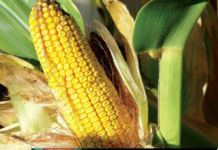On Wednesday, approximately 106 people on the Wheat Quality Council’s 2023 winter wheat tour made their way from Colby to Wichita, Kansas, stopping in wheat fields along six different routes.
Wednesday’s wheat tour scouts made 276 stops at wheat fields across western, central and southern Kansas, and into northern counties in Oklahoma. The wheat in Southwest Kansas looks rough, with intense drought conditions, poor stands and some freeze damage. During the tour, participants saw how far east these drought conditions reached. Short wheat plants even extended into central Kansas, like around Wichita. In central Kansas, many scouts reported seeing hail damaged wheat, and the first apparent signs of pest damage.
The calculated yield from all cars was 27.5 bushels per acre. This yield estimate is only for the fields that will make it to harvest, and does not account for the large amount of abandoned fields that were seen. Scouts were able to mainly use the late season formula provided by USDA’s National Agricultural Statistics Service, which includes counting wheat heads, number of spikelets and kernels per spikelet. The calculated yields were based on this formula, but many tour participants remarked that those yields seemed high. The wheat is so short that some of the heads will not be able to be picked up by the combines at harvest. The yield formula doesn’t take abandonment, disease, pests or weed pressure into consideration. Scouts saw some instances of wheat streak mosaic virus, into areas farther east than expected or typical, but western Kansas didn’t have many instances of WSMV because of the drought.
Mike Shulte from Oklahoma Wheat Commission reported that the state’s production estimate numbers, presented at the Oklahoma Grain Feed Association, were 49.9 million bushels, with about 2.2 million acres of wheat harvested out of 4.6 million acres planted. They had an estimated yield of 23 bushels per acre. Shulte reported the four largest wheat producing counties in Oklahoma are looking very rough, extremely dry. They did not receive enough moisture, and many farmers are cutting their wheat for hay.
Many of the day’s drivers were able to introduce wheat tour participants to farmers around western Kansas. Getting this chance for end users to talk with producers gives everyone across the industry a glimpse into each other’s lives and how they contribute to the “grain chain.”
For one participant, Mariam Dunlin with Ardent Mills, this was her first wheat tour.
“I have been so excited to be able to get out into the field, see the wheat growing, talk to farmers, learn more about the industry that I really only have a small materialist snapshot of what actually happens,” Dunlin said. “The first day I was with a farmer that was one of people in my car, just learning about how much management for several years goes into producing the wheat crop. You might be planting cover crop, beans, soybeans, corn, for three and four years, you might be leaving your field fallow to be able to for one year grow, hopefully grow a wheat crop that will pay off and be a high yield, high quality crop and just getting to know about that I think has been a massive eye opener.”
Wheat Tour 23 continues Thursday with six routes between Wichita and Manhattan. Follow along with the tour at #wheattour23. A final production estimate will be announced Thursday afternoon.
###




